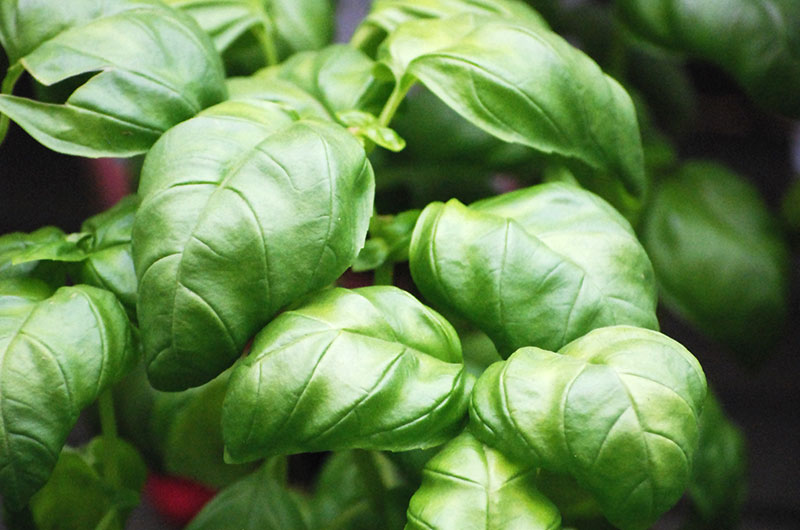One dim and chilly day last winter, I slipped into the warmth of the Island Grown Initiative’s greenhouse at Thimble Farm, and, while nobody was looking, did a face plant in a flat of fragrant basil. Ah. That smell! Summer! Only…it wasn’t. But my brain didn’t seem to realize that. Suddenly, my internal Google Map zoomed out, up, over, and down onto another Island farm about eight miles west and eight years ago.
It was a hot, bee-buzzing, gentle-breezing early August day at Native Earth Teaching Farm. Pygmy goats (my ostensible interview subjects) wandered the sandy road, munching weeds, and scattering a noisy flock of guinea hens. At last I found their proprietor, Rebecca Gilbert, waist deep in a sea of fragrant basil. And not just any basil – lime basil, lemon basil, Thai basil. I’d never seen such basil. I forgot all about the goats and got lost in a fascinating conversation with Gilbert that would set me on the road to growing my own interesting selection of basil varieties in the following years.
Such is the mnemonic power of basil. One sniff of that licorice- and lemon-laced aroma and you are transported to a sunny day, a wonderful al fresco meal, a friend’s kitchen garden.
On that winter day, I was surprised to learn that heat-loving basil now grows year-round on the Vineyard, thanks to Island Grown Initiative’s greenhouse and hydroponic growing system. Farm Hub program leader Keith Wilda told me that the ideal germinating temperature for basil is about 72 degrees, and since it loves plenty of water and nitrogen, the hydroponic system is ideal.
A greenhouse environment (or a hoop house, as I learned from my own experience) offers another perk – protection. Protection from certain basil-eating pests and from unexpected cold snaps (even in summer). The great takeaway is this: You can make your own mini “hoop house” for basil in your garden with fabric row cover, wire hoops, and bricks or staples to hold the fabric down. I have grown beautiful hole-less basil this way, because the cover keeps the Japanese beetles out. It also helps the bed retain moisture and gives a small degree of protection from the sun’s harshest rays.
Because while basil loves heat, it doesn’t necessarily like or need the full-on, all-day sun that the tomatoes and eggplants we often plant it near do. Parched or wilted basil is a sad sight; consistent watering is essential to prevent this. But partial shade is helpful, too.
That’s why a container can be ideal for growing a small amount of basil. You can position the container (choose a tall, deep one rather than a wide, shallow one) in a spot near your house – like a sunny backdoor step – where it might get a bit of afternoon shade. If it’s close by, you’ll remember to water it – and you’ll cook with it more. Be sure to add compost to your potting soil and use a liquid seaweed fertilizer on the plant (or plants) every few weeks. Pinch the plants back (or harvest a few sets of top leaves) when they’re young to encourage branching and to prevent flowering. When flower buds do appear, pinch them off and add to salads. Or let a few plants go – the long stems of flowering Thai basil are so pretty and sturdy that I use them in flower arrangements. (And in curries, of course.)
Next year, if you want to start basil from seed, check out seedman.com or fedcoseeds.com for some really interesting varieties. (Wilda recommends looking for those that are resistant to fusarium wilt.) The choices are astounding; there are more than 100 varieties of basil worldwide. You could try cinnamon basil, Aristotle bush basil, Caesar basil, Mrs. Burns lemon basil, or Gilbert’s new favorite – Tulsi, or holy basil (Ocimum sanctum, as opposed to Ocimum basilicum, our more familiar sweet culinary basil). Holy basil, which is native to tropical Asia, has been used in Ayurvedic medicine for centuries. While all basils are thought to be antibacterial and anti-inflammatory, holy basil may help regulate stress hormones and potentially has many other health benefits. Gilbert makes a tea from Tulsi leaves.
I’m also planning to grow Globe basil – a small plant with tiny leaves that are perfect for plucking whole and tossing in salads. I often use whole small (or torn larger) leaves of basil since this is one herb that bruises very easily, especially when chopped with a dull knife. If I need a large amount of chopped basil, I take advantage of the speedy, sharp blades of the food processor. I’ve used whole and chopped in the grain salad I’ve included here.
So whether you’re planning to make a lot of insalata caprese and linguine al pesto this summer, or you just like the smell of fresh basil, you can’t go wrong with adding a few plants to your garden, deck, or patio.
And be sure to do a face plant in your basil patch every once in a while. No telling where that fragrance will take you.
The following recipe was originally publised with this article:
Double Basil Summer Grain Salad with Cherry Tomatoes, Cucumbers, Nectarines,
Fresh Corn, and Avocado







